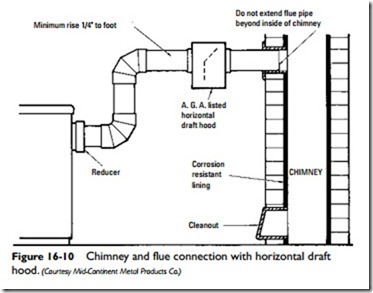Flue Pipe and Chimney
The flue pipe is a pipe connecting the smoke outlet of the furnace or boiler with the flue of a chimney (Figures 16-10 and 16-11). It should not extend beyond the inner liner of the chimney and should never be connected with the flue of an open fireplace. Furthermore, flue connections from two or more sources should never enter the chimney at the same level from opposing sides.
Flue pipe should be constructed from corrosive resistant metal and be designed with as few sharp turns as practical. The straightest and shortest possible passage should be provided for the existing flue gases.
Pitch the flue pipe with a rise toward the chimney of at least 1⁄4 in per foot. At approximate intervals, fasten the flue pipe securely with sheet-metal screws to prevent sagging.
Masonry is recommended for the construction of chimneys (pre- fab chimneys are also found suitable). Outside metal stacks are generally unsuitable for oil-fired burners.
The ordinary chimney must be at least 3 ft higher than the roof or 2 ft higher than any ridge within 10 ft of the building in order to avoid downdrafts.
Aside from adapting the furnace or boiler for a conversion burner, changes must also be made in the passages formed by the heating surface.
Extra-large flue passages are not suited to the high-temperature flue gas encountered with oil. In boilers having these large flue pas- sages, baffling must be used to slow down the high velocities of the extra-hot gases; otherwise unburned particles of oil may lodge on the heating surface, resulting in carbon deposits. Because carbon is an excellent insulator, the efficiency of the heating surface is lowered whenever it collects. (See the following section.)
Baffling
Baffling is a type of obstruction designed to deflect and regulate the speed of flue gases. Baffles are especially necessary for round boilers and furnaces constructed so that the flue passages are almost direct from the firebox. Furthermore, boilers designed for burning coal are usually provided with relatively large flue passages, which are not normally suited to the higher flue gas velocities encountered in oil firing.
Baffling will, in most cases, help to overcome the inefficient operation resulting from the usual excessively high stack-gas temperatures. In such instances it is advisable to experiment with various methods of baffling as shown in Figure 16-12.
Note
Any baffling of the flue passages that prevents efficient operation of the burner should not be done.
Another form of baffling is a corbel, or stepout, arrangement of the brickwork of the rear wall, forming a target wall that the flame strikes and is curled back to prevent short circuiting.

